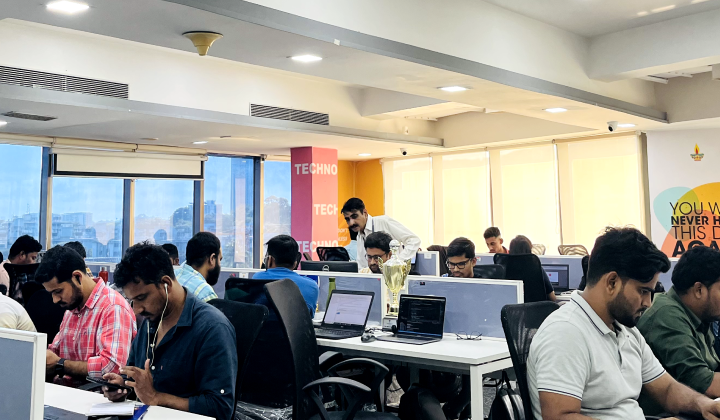Looking to bring innovative products to life, but worried about the high costs of hiring full-time staff or overloading your current team? Outsourced product development might be the perfect solution for you.
This strategy allows you to leverage the expertise of a global tech talent pool, often at a more affordable rate. This keeps you ahead of the curve compared to your competitors.
But that’s just the beginning! In this guide, we’ll explore the many advantages of outsourcing product development, along with the ideal projects and times to consider it. We’ll also provide key steps to help you find the perfect outsourcing partner for your needs.
Additionally, we’ll discuss how partnering with OnextDigital, an experienced outsourcing company can streamline the entire process for you.
What is Outsourced Product Development?
Leveraging external muscle is what outsourced product development is all about. You bring in specialized service providers to handle the design, engineering, and development of your software solution.
Flexibility is key with this approach. You can outsource the entire product development journey, from project management to ongoing maintenance. Alternatively, you can choose to delegate specific tasks or stages to the experts you hire.
Imagine building a mobile app. Outsourcing product UI design or beta testing to external specialists frees up your internal team to focus on core functionalities like coding and feature development. This way, you gain access to a global pool of talent with specialized skills you might not have in-house, often at a more cost-effective rate. It’s a win-win: your internal team stays focused on core strengths while your product benefits from a wider range of expertise.
3 Ways to Bring in Extra Help for Product Development
There are three main approaches to outsourced product development, each with its own geographical advantages:
- Nearshoring: Partner with a company in a nearby country. This offers benefits like shorter travel times for meetings, shared cultural understanding, and convenient time zone overlap. Costs for nearshoring are typically lower than in-house development and traditional onshore outsourcing.
- Offshoring: This involves delegating product development tasks to a team located in a distant country. Significant cost savings are a major advantage. However, potential language barriers and time zone differences can pose challenges.
- Onshoring: Here, you partner with outsourcing companies within your own country. This ensures smooth communication and cultural alignment but typically comes at a higher cost compared to the other two options.
What Product Development Services Can You Outsource?
Taking on the entire product development process yourself can be a strain on resources. Fortunately, outsourced product development allows you to bring in expertise for specific tasks. Here’s a range of services you can delegate to a qualified partner:
- Conceptualizing and building prototypes: Turn your initial ideas into tangible models to test and refine.
- Full product engineering: From design and architecture to coding and functionality, outsource the entire technical development process.
- Product design: Get help crafting a user-friendly and visually appealing interface for your product.
- Defining the product’s core structure: Outsource the planning of your product’s underlying framework to ensure smooth operation.
- Building custom products: If your needs are unique, outsource the development of a product tailored specifically for your market.
- Mobile and web app development: Leverage specialists to create user-friendly applications that seamlessly integrate with your product.
- Project oversight and management: Offload the responsibility of keeping your development project on track and within budget.
- Ensuring quality: Outsource thorough testing to identify and fix any bugs or glitches before launch.
- Hardware upkeep and upgrades: Get expert assistance with maintaining and improving the physical components of your product.
- Optimizing performance: Delegate the task of monitoring and fine-tuning your product for optimal speed and efficiency.
- Technical support: Provide your users with a reliable source of troubleshooting and problem-solving through outsourced support.
- Data management: Ensure the secure storage and backup of your product’s crucial information.
By strategically outsourcing these services, you can free up your internal resources and focus on your core business strengths.
When to Consider Outsourced Product Development
Turn to outsourced product development in several key situations:
- Skill and Resource Gaps: Your internal team might lack the specific skills or resources required to complete a project. Outsourced product development bridges this gap by providing access to specialized expertise.
- Budget and Infrastructure Constraints: Limited budgets or infrastructure limitations can hinder in-house development. Outsourcing offers a cost-effective solution, eliminating the need for full-time hires and extensive hardware/software investments.
- Time Crunch: Tight deadlines can strain your existing team. Outsourcing allows you to meet those deadlines by leveraging additional development power without overburdening internal resources.
- Temporary Projects: For one-off projects that don’t necessitate a permanent team, outsourcing provides a flexible solution, avoiding long-term hiring commitments.
- Regulatory Hurdles: Expanding into new markets often involves navigating unfamiliar regulations. Outsourced product development partners with local expertise can help ensure compliance.
- Cost-Effective Solutions: Building complex software like e-commerce platforms or accounting systems can be expensive. Outsourcing offers a more cost-effective approach to bring such solutions to market.
- Focus on Core Strengths: Outsourcing frees up your internal team’s time, allowing them to focus on core competencies and strategic initiatives.
By addressing these situations, outsourced product development helps streamline your development process, optimize costs, and ultimately achieve your business goals.
Leveraging Outsourced Product Development for Success: 7 Key Advantages
Building great products requires a strategic approach. Here’s how outsourced product development offers 7 key benefits to boost your business:
1. Access to Top Talent:
Outsource and tap into a global pool of experts. Find specialists with unique skills, overcoming geographical limitations. Imagine needing cutting-edge virtual reality (VR) development. Partnering with a trusted outsourcing firm lets you hire VR specialists you might not find locally.
2. Cost Savings:
Building an in-house team can be expensive. From recruitment to office space, the costs add up. Outsourcing lets you hire skilled developers without these burdens. Plus, nearshoring lets you access talent in regions with lower living costs. For instance, a US company could hire a product developer in Eastern Europe for a fraction of the cost compared to hiring locally.
3. Faster Market Launch:
Time is money. Outsourced partners bring specialized skills and established workflows, accelerating development. Skip the learning curve and get your product to market quicker. Nearshoring can further expedite this by leveraging similar time zones for seamless collaboration. Imagine a development team in Singapore working with a US company – just a 12-hour difference facilitates real-time communication and faster issue resolution.
4. Regulatory Compliance:
Outsourcing partners often navigate various industry regulations. This is crucial if your product needs to meet complex international standards. Their expertise is invaluable when entering new markets. For example, a European company launching a medical device in the US could benefit from partnering with a US-based product development firm. Their knowledge of FDA regulations ensures your product adheres to local standards for a smooth market entry.
5. Fresh Ideas and Innovation:
External teams bring diverse perspectives, sparking innovation and creative problem-solving. Consider outsourcing your product’s initial design phase. A fresh set of eyes can identify unique user needs and suggest innovative solutions, leading to a product that resonates with your target audience.
6. Scalability and Flexibility:
Outsourcing allows you to scale your development team up or down as needed. Need data science expertise for a specific project phase? Outsourcing lets you add data scientists to your team temporarily, avoiding long-term hiring commitments. This flexibility is crucial for adapting to changing market demands and project requirements.
7. Focus on Your Core Business:
Outsourcing frees up your internal team to focus on core business strategies. Skilled external teams manage the day-to-day development tasks, minimizing the need for micromanagement. This allows your team to concentrate on higher-level strategic initiatives that drive growth.
Now, let’s explore the factors that influence the cost of outsourced product development.
6 Key Factors Affecting Outsourced Product Development Costs
The final price tag of your outsourced product development project can be influenced by several key factors. Let’s explore these factors to help you make informed decisions.
1. Location, Location, Location:
Costs can vary significantly depending on where your development team is based. This is due to differences in living expenses, currency exchange rates, and developer salaries across countries. Hiring a developer in Eastern Europe might cost you considerably less compared to someone with the same skillset in Western Europe or North America.
2. Project Complexity and Timeline:
The more intricate and time-consuming your project is, the higher the development costs will likely be. Complex projects often demand specialized skills, advanced technology, and more developer hours, all of which contribute to the overall cost. Developing a mobile game with basic features may be significantly cheaper compared to building a sophisticated application requiring features like augmented reality.
3. Developer Expertise:
Experience plays a big role in developer salaries. Junior developers, though enthusiastic, might require more guidance and oversight, potentially impacting project timelines. Conversely, highly experienced developers with proven track records will command higher fees but can streamline the development process and deliver superior results.
4. Pricing Models:
The way you choose to pay for development services will also affect your budget. There are three main options to consider:
- Fixed-Price Model: This offers upfront cost certainty but can be inflexible if project needs evolve.
- Time and Materials Model: This provides greater flexibility but costs might fluctuate based on actual time spent and resources used.
- Value-Based Pricing Model: This ties development costs to the projected value and return on investment (ROI) of the product. While potentially lucrative for highly innovative products, it can involve complex calculations and negotiations.
5. Software Integrations:
Integrating existing software tools into your product can impact cost. Simple integrations, like adding standard payment gateways, are generally straightforward and affordable. However, complex integrations requiring custom development or advanced data analytics will necessitate specialized skills and comprehensive planning, leading to higher outsourcing costs.
6. Post-Deployment Support:
The work doesn’t stop after launch. Ongoing maintenance, bug fixes, and technical support are crucial for ensuring your product’s functionality, security, and performance. Be sure to factor in these ongoing costs when planning your outsourced product development budget.
By understanding these factors, you’ll be better equipped to make informed decisions and navigate the costs associated with outsourced product development.
We’ve explored the cost considerations, but outsourcing isn’t without its potential drawbacks. Let’s delve into some key challenges to be aware of before making the leap.
You Should Be Aware of These 4 Outsourced Product Development Risks
While outsourced product development offers many benefits, it’s important to be aware of potential challenges that can arise. Here are four key risks to consider:
- Communication Roadblocks: Working with teams in different time zones and cultures can lead to misunderstandings. Language barriers and cultural differences can make it difficult to clearly convey ideas and expectations. Significant time zone gaps can also cause delays as team members wait for responses.
- Maintaining Control: Outsourcing often involves less direct oversight compared to in-house development. This can make it trickier to ensure projects stay on track and meet quality standards. Building trust with your outsourcing partner is crucial to avoid misalignment and potential issues.
- Unexpected Costs: Unforeseen expenses can eat into your budget. This might include legal fees, training for external teams to understand your specific needs, or additional costs to fix bugs caused by communication gaps. Choosing a reputable provider with a transparent pricing structure can help minimize these risks.
- Protecting Your Ideas: Sharing sensitive product information with an outsourcing partner is necessary for successful collaboration. However, this raises concerns about intellectual property (IP) theft and data security. Make sure your chosen partner has strong security measures in place and clear policies to protect your intellectual property.
By carefully selecting a reliable outsourcing partner and proactively managing these risks, you can minimize their impact and ensure a successful outsourced product development experience. We’ll explore how to choose the right partner in the next section.
10 Steps to Finding a Reliable Outsourced Product Development Partner
Choosing the right partner for outsourced product development is key to achieving your business goals. Here are 10 steps to guide you:
1. Define Your Vision Clearly:
Start by creating a detailed project scope outlining your goals, deliverables, and timelines. This ensures everyone’s on the same page. Additionally, craft a software requirements document (PRD) specifying design, technical needs, user interface, and performance expectations. Clear documentation prevents misunderstandings and helps the outsourced team deliver what you need.
2. Research and Evaluate Potential Partners:
Investigate their portfolios, client testimonials, and industry experience to assess their expertise. Look for companies with a proven track record of success in your field.
3. Set a Budget for Success:
Having a clear budget helps you find a partner that delivers quality work within your financial constraints. It also minimizes the risk of unexpected costs. A realistic budget will determine the level of developer experience you can access.
4. Quality Assurance Matters:
Learn about their quality assurance (QA) processes, including testing protocols and how they handle bug detection, tracking, and resolution. A strong QA approach increases the likelihood of a reliable, user-friendly product.
5. Streamlined Communication and Project Management:
Find out if they use flexible project management methods like Agile or Scrum, which facilitate adaptable workflows and easier change management. Agree on communication tools (Slack) and project management software (Asana or Jira) for clear and consistent updates. Establish communication protocols like meeting schedules and emergency contact points.
6. Track Progress with Clear Metrics:
Define Key Performance Indicators (KPIs) and metrics to track project progress and performance objectively. This allows both parties to assess if the project aligns with goals and timelines. Some KPIs to consider include sprint burnout, kilo lines of code defects, and story points completed.
7. Proactive Risk Management:
Ensure they have a plan to identify and mitigate potential development challenges, such as scope creep, resource limitations, or delays. For instance, a strong cybersecurity plan with regular audits can prevent data breaches.
8. Post-Launch Support is Crucial:
Continuous maintenance and updates are essential to keep your product competitive in the market and address user feedback promptly. Look for a partner who offers regular software updates, bug fixes, feature improvements, and system health checks.
9. Plan for a Smooth Transition:
Choose a partner with a clear exit strategy for transferring project materials, documents, and knowledge if the partnership ends. This includes source code and details about project history and challenges to ensure minimal disruption during a transition.
10. Protect Your Ideas:
Discuss intellectual property (IP) policies and sign a Non-Disclosure Agreement (NDA) to safeguard your ideas and confidential information. Additionally, research the IP policies and data security laws of the outsourcing country.
By following these steps, you’ll be well on your way to finding a reliable outsourced product development partner to bring your vision to life.
Conclusion
Outsourced product development is generally a wise strategic decision for firms since it provides access to worldwide technical competence, cost effectiveness, and quicker market penetration.
However, nearshore product development with a partner like Onextdigital stands out as the least complicated approach because it provides superior communication, cultural affinity, and time zone alignment while upholding high standards of quality.
Here’s how to do it:
Since its founding in 2010, ONEXT DIGITAL has established itself as a leading Vietnamese software outsourcing business with a clientele that spans the globe. Our goal is to provide solutions that are focused on the future while maintaining the organization’s stability and growth. We are dedicated to providing top-notch, creative, and economical software products because of our skilled staff.
To help your online business succeed, we offer a variety of expert solutions and services, including eCommerce, Web and App Development, Mobile App Development, UX/UI Design Service, White Label Software Service, and CRM & Auto Marketing Automation Solution.
Contact us right now to take advantage of these unmatched advantages and start bringing your product idea to life.









